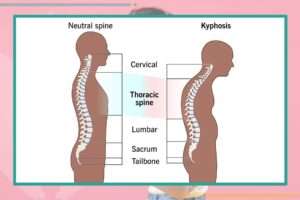What Is a Spinal Kyphosis or Hunch Back?
Exaggerated forward curvature of the spine, or Hunch Back, is sometimes brought on by injury, heredity, or bad posture. Both discomfort and appearance may result from it. The condition known as hyperkyphosis, roundback, or extreme forward curvature of the upper back, or curvature of more than 50 degrees, is called kyphosis of the spine. The words “hunchback” and “dowager hump,” which are no longer accepted medical terms, were once used to describe the ailment.
 There is a small curvature to the thoracic portion of the spine, which is the upper back. In order to support the weight of the head and assist absorb shock, the spine naturally curves in the neck, upper back, and lower back. When the vertebrae—the bones that make up the spine—become deformed and exhibit an enlarged natural curve, it is known as kyphosis.
There is a small curvature to the thoracic portion of the spine, which is the upper back. In order to support the weight of the head and assist absorb shock, the spine naturally curves in the neck, upper back, and lower back. When the vertebrae—the bones that make up the spine—become deformed and exhibit an enlarged natural curve, it is known as kyphosis.
Further Details on Hunch Back
It’s possible for someone with mild kyphosis to be symptomless. On the other hand, people with moderate to severe kyphosis could noticeably circle their upper back and have back discomfort and stiffness. Breathing issues may arise from kyphosis in certain instances when there is excessive strain on the lungs and spine.
Your spine may curve outward more than it should if you have kyphosis. This results in a forward bend in your upper back around the thoracic region, which is the area of your spine between your neck and ribs. It may appear as though you’re slouching or bent over due to the curvature. It is occasionally referred to as a “roundback” or “hunchback.”
The bends in your spine are natural. You can stand erect and maintain good posture with the aid of these curves. However, too much curvature can strain your body and make standing uncomfortable.
Kyphosis rarely results in health issues or necessitates medical attention. However, you can become self-conscious about your appearance as a result. Severe forms of kyphosis may result in pain or difficulty breathing. Surgery can be needed for severe kyphosis.
Kyphosis Symptoms
The symptoms and indicators of kyphosis differ. They also rely on the spinal curve’s genesis and degree of severity. They include:
* Rounded shoulders
* A noticeable hump on the back, a discrepancy in shoulder height, soreness or stiffness in the shoulders and back, exhaustion, and taut hamstrings (the muscles at the rear of the leg)
Rarely, kyphosis can also result in side effects like:
* Weakness and tingling or numbness in the legs
* Having either bladder or bowel incontinence
* Breathlessness or other breathing problems
Hunch Back Causes
Depending on the kind, there are several potential causes of kyphosis. These include:
- Poor posture.
- Irregularities in the structure of your spine’s bones.
- Anomalies in the growth of bones (bone form).
- Spinal damage.
- How old you are.
Can Scoliosis Develop from Hunch Back?
No. Your spine can be affected by both scoliosis and kyphosis. Although they might occur simultaneously, one does not trigger the other. The abnormal bending of the spine from front to back is known as kyphosis. The abnormal curvature of the spine, either horizontally or from left to right, is known as scoliosis.
Kyphosis may develop later in life or be present from birth. In addition to Scheuermann’s disease, bad posture, and congenital conditions, additional causes of kyphosis include:
1. Fractures to the spine osteoporosis, or a decrease in bone density.
2. Degenerative conditions affecting the spine, such as arthritis or disc degeneration, scoliosis, or trauma resulting in misaligned vertebrae, sometimes referred to as “slipped discs,” or an unusual spinal curvature injury.
Less frequent kyphosis reasons include:
– Spinal infection congenital anomalies, like spina bifida spinal tumors
– Disorders of the connective tissue
Paget’s disease, which causes big, brittle, malformed bones to grow quickly
– Muscle atrophy
– Polio
Hunch Back Types:
The following are the three forms of kyphosis that are most frequently seen:
Postural Kyphosis
The most prevalent kind of kyphosis is postural kyphosis. It typically occurs while you are a teenager. Your vertebrae, or spinal bones, are held in place by ligaments and muscles that are stretched by slouching or bad posture. Your spine becomes rounded as a result of stretching because it forces your vertebrae out of their natural alignment. More children assigned to be female at birth than those assigned to be male are affected by it. In most cases, it doesn’t hurt.
Scheuermann’s Illness
The disorder known as Scheuermann’s kyphosis is named for the Danish radiologist who made the initial discovery of it. Scheuermann’s kyphosis also most frequently affects youths, much like postural kyphosis.
In contrast to postural kyphosis, it is more common in men. Standing upright will not cure Scheuermann’s kyphosis, which is brought on by a structural anomaly in the spine, typically including three or more unevenly formed vertebrae.
The patient may experience pain from the rigidity of the asymmetrical curve when engaging in physical activity or after spending extended amounts of time standing or sitting.
This kind is caused by vertebrae that are shaped differently than they should be. Your vertebrae are shaped like a wedge rather than like rectangles. Your spine seems rounded because of the way the wedge-shaped bones curve forward. It has a greater impact on male-born children than on female-born children. Scheuermann’s kyphosis can cause discomfort, particularly when moving around or spending extended periods of time sitting or standing. Since your vertebrae are not flexible, changing your posture or position won’t alter the curve.
Discover the Pros and Cons about Dental Veneers
Kyphosis Congenita
When an infant’s spine develops improperly in the pregnancy, it is known as congenital kyphosis. Vertebrae, for instance, may be cleft or fused together. Congenital kyphosis patients may also have additional birth problems affecting the kidneys and heart, and they usually need corrective surgery early in life. Congenital refers to a condition that exists from birth.
When your spine is not fully developed in the uterus, it might result in congenital kyphosis. As you become bigger, it may get worse. To stop the curvature of the spine from getting worse in children, surgery might be used to rectify it. It may also occur in conjunction with other congenital growth problems, such as kidney and heart defects.
Military Neck
Also known as cervical kyphosis, is a condition in which the normal curve of your cervical spine—which runs from the base of your head to your upper back—becomes more pronounced in the front than it does in the back.
Hyperkyphosis
A significant forward curvature of the spine in hyperkyphosis. There are more than fifty degrees on the curve. After forty, this kind is more prevalent.
Frequent Questions about Hunch Back
What would happen if kyphosis was not addressed?
If kyphosis is not treated, it can lead to difficulties like breathing problems, limb weakness or numbness, restricted movement, deformity in the back, and chronic back pain.
Is kyphosis reversible?
Through regular exercise or physical therapy, one can strengthen their back muscles and improve their posture to correct postural kyphosis. Similar techniques can be used to treat Scheuermann’s kyphosis in children as they get older. Surgery will probably be required to rectify the curvature in those with more severe or congenital kyphosis.
And what distinguishes lordosis from kyphosis?
Similar to kyphosis, lordosis affects the lower spine’s inward curvature. Lordosis, commonly referred to as “swayback,” affects the inward curvature of the spine, as opposed to kyphosis, which causes an extreme forward bend in the spine. Certain lordosis exercises can provide symptom relief.
How often does kyphosis occur?
In the US, fewer than 8% of school-age children suffer with Scheuermann’s kyphosis. In persons over 60, hyperkyphosis, or severe kyphosis, is thought to impact 20% to 40% of cases. Your upper spine’s forward tilt rises by roughly 3 degrees on average every ten years.
Are you thinking if Does Hair Transplant for Women Work?
Which variables put one at risk for kyphosis?
Between the ages of 13 and 16, postural and Scheuermann’s kyphosis are frequently diagnosed. This is a result of the fast-expanding bones of teenagers. However, it can appear in people of any age. Humans’ aging vertebrae become less flexible, which can cause the spine to tilt forward.
The congenital form of kyphosis is another condition that might be born. This may occur in addition to other underlying medical issues that impact the formation and growth of your body inside the uterus.
What consequences might kyphosis cause?
Although complications are uncommon in moderate types of kyphosis, they can occur in those with severe spinal curvature. Possible complications include:
- Back discomfort.
- Walking is difficult.
- Respiratory discomfort due to lung compression.
- Neural problems, such as pinched nerves.
What examinations identify kyphosis?
Your doctor can identify the issue by measuring the curvature of your spine with the aid of a spine X-ray. The natural curve ranges in angle from 20 to 45 degrees. If the bend is more than fifty degrees, your physician will diagnose kyphosis.
Furthermore, your medical professional will recommend testing to ascertain whether the cause of your symptoms is an underlying illness or if the curvature of your spine has an impact on other areas of your body. Tests could consist of:
– A pulmonary function test to gauge the health of your lungs.
– To find out if the bend in your spine is putting pressure on your spinal nerves, get an MRI.





